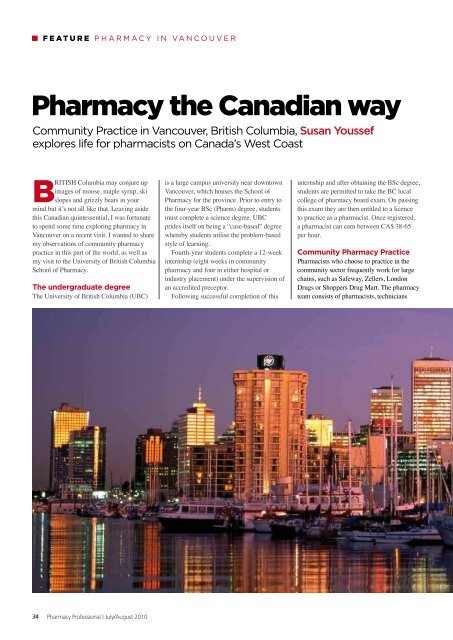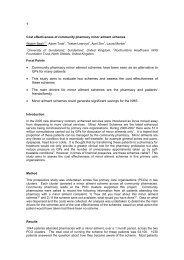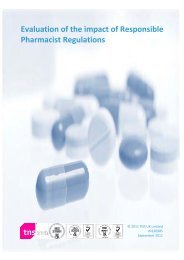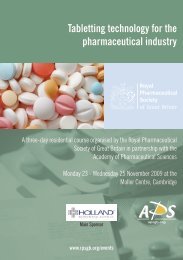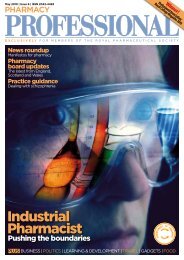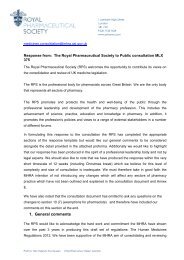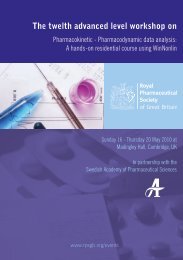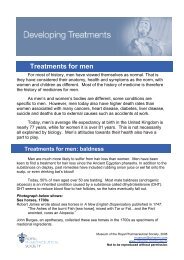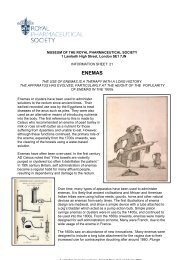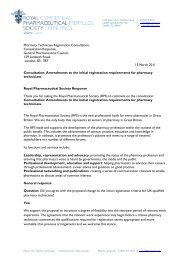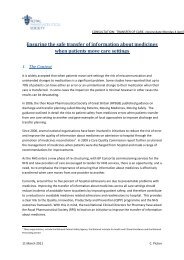victorian Pharmacy - Royal Pharmaceutical Society
victorian Pharmacy - Royal Pharmaceutical Society
victorian Pharmacy - Royal Pharmaceutical Society
You also want an ePaper? Increase the reach of your titles
YUMPU automatically turns print PDFs into web optimized ePapers that Google loves.
f e at u r e P h a r m a c y i n va n c o u v e r<br />
<strong>Pharmacy</strong> the Canadian way<br />
Community Practice in Vancouver, British Columbia, Susan Youssef<br />
explores life for pharmacists on Canada’s West Coast<br />
BritiSH Columbia may conjure up<br />
images of moose, maple syrup, ski<br />
slopes and grizzly bears in your<br />
mind but it’s not all like that. Leaving aside<br />
this Canadian quintessential, I was fortunate<br />
to spend some time exploring pharmacy in<br />
Vancouver on a recent visit. I wanted to share<br />
my observations of community pharmacy<br />
practice in this part of the world, as well as<br />
my visit to the University of British Columbia<br />
School of <strong>Pharmacy</strong>.<br />
The undergraduate degree<br />
The University of British Columbia (UBC)<br />
is a large campus university near downtown<br />
Vancouver, which houses the School of<br />
<strong>Pharmacy</strong> for the province. Prior to entry to<br />
the four-year BSc (Pharm) degree, students<br />
must complete a science degree. UBC<br />
prides itself on being a “case-based” degree<br />
whereby students utilise the problem-based<br />
style of learning.<br />
Fourth-year students complete a 12-week<br />
internship (eight weeks in community<br />
pharmacy and four in either hospital or<br />
industry placement) under the supervision of<br />
an accredited preceptor.<br />
Following successful completion of this<br />
internship and after obtaining the BSc degree,<br />
students are permitted to take the BC local<br />
college of pharmacy board exam. On passing<br />
this exam they are then entitled to a licence<br />
to practice as a pharmacist. Once registered,<br />
a pharmacist can earn between CA$ 38-65<br />
per hour.<br />
Community <strong>Pharmacy</strong> Practice<br />
Pharmacists who choose to practice in the<br />
community sector frequently work for large<br />
chains, such as Safeway, Zellers, London<br />
Drugs or Shoppers Drug Mart. The pharmacy<br />
team consists of pharmacists, technicians<br />
and fourth year pharmacy students in stores<br />
with accredited preceptors. However, unlike<br />
the UK’s healthcare system, the Canadian<br />
system is based on insurance plans through<br />
Pharmacare.<br />
Pharmacare<br />
The pharmacist accepts a prescription from<br />
the patient at the front desk and also asks for<br />
the patient’s Pharmacare card. Each patient<br />
has an insurance plan with Pharmacare which<br />
determines the level of care they are entitled<br />
to. To be eligible for a Pharmacare plan a BC<br />
resident must have a Medical Services Plan<br />
and have submitted a completed income tax<br />
return based on their personal income from<br />
two years previously.<br />
Each patient pays the full cost of<br />
prescriptions until they reach a level known<br />
as their deductible. Once the deductible<br />
is reached Pharmacare starts to provide<br />
assistance with drug costs. For example,<br />
if the net annual family income is over<br />
CA$30,000 the family deductible will<br />
be equal to 3% of the net income (i.e.<br />
CA$1000). Once this deductible has been<br />
reached, Pharmacare would provide 70%<br />
coverage of drug costs for the rest of the year.<br />
‘PharmaNet’<br />
At the point of dispensing, the pharmacist<br />
checks the patient’s Pharmacare plan using<br />
‘PharmaNet’. This enables the pharmacist<br />
to charge the patient the correct price for<br />
their medication based on their deductible.<br />
All pharmacies in BC have access to<br />
‘PharmaNet’, allowing them to see all<br />
prescriptions dispensed for that patient within<br />
BC. This minimises the potential for drug<br />
interactions which result from prescriptions<br />
being dispensed by multiple pharmacies.<br />
Other information stored on ‘PharmaNet’<br />
includes drug allergies, clinical conditions,<br />
Æ<br />
34 <strong>Pharmacy</strong> Professional | July/August 2010 July/August 2010 | <strong>Pharmacy</strong> Professional 35


